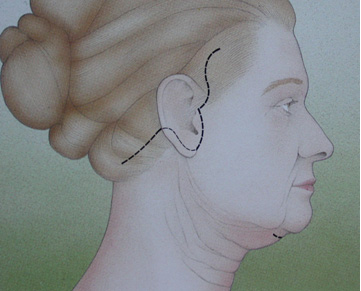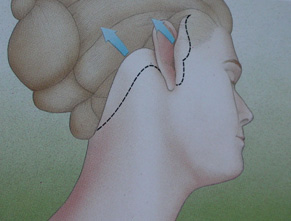Things to consider before a facelift operation.
If you consider facelift surgery, the first step to take is to consult a plastic surgeon. The patient should openly discuss with the surgeon his/her expectations about his/her appearance and feelings after surgery. Before any plastic surgery, being in an emotionally balanced state is one of the most important conditions. Plastic surgery will improve your appearance and refresh your self-confidence.
After your examination your surgeon will discuss with you other things that will affect the decisions on the surgical procedure. Although it is said that you will look five to ten years younger a result of facelift, it is not possible to predict the result exactly. To be realistic, a successful facelift will make the patient look better for his/her age. Factors such as age, bone structure, personal characteristics of the skin, habits (alcohol use, diet, smoking etc.) and genetic factors will determine the degree of improvement.

During your first visit, the surgeon will explain the specific details including the surgical technique, the type of anesthesia, where the operation will be performed and what you must realistically expect from the surgery. During your visit, you should get information from the surgeon about other factors such as the risks and costs that should be taken into account before deciding on facelift surgery.
Every year thousands of facelift surgeries are performed successfully. Despite being rare, postoperative complications such as delayed healing, localized blood accumulation, and infection are observed. Inadequate healing considerably increases scarring and can sometimes require a second surgical intervention. If you follow your surgeon’s care recommendations during the recovery period, your risk of complications will be minimal.
The price of facelift surgery and the material costs may vary from case to case. The cost will increase depending on the duration and difficulty of the surgical operation. There may be extra costs depending on the type of anesthesia and the hospital where the surgery will be performed.
Face Lift Surgery—Surgical Intervention...
A typical facelift surgery is performed to eliminate excessively slack or saggy skin on the face and neck (Figure 1). The extent of the procedure depends on what changes are demanded and what your surgeon deems appropriate for you. If that patient wants to get rid of the bags around the eyes, eyelid surgery (blepharoplasty) can be performed in conjunction with the facelift operation or as a separate surgical intervention.

Figure 1: The appearance of the patient who is a suitable candidate for facelift surgery. Deep wrinkles on the cheek, skin accumulation on the jawbone, slack skin accumulation on the neck and saggy skin.
Facelift is performed under general anesthesia or local anesthesia that involves numbing only the nose area. Before anesthesia, you will be given a sedative, which will help you relax. The sedative and local anesthetic will keep you comfortable during the surgery. If the surgery will be performed under general anesthesia, you will be asleep throughout the entire operation.
The face lift procedure is applied first to one side of the face and then to the other. The hairline is slightly shaved before the incision. The incisions to be made may differ depending on the patient’s specific needs and the technique to be used by the surgeon. In many cases, the incision made behind the hairline begins from the temples and continues down following the natural line around the earlobe, and extends to the back of the head or the nape of the neck (Figure 2). Sometimes the incision extends to the inside the front of the ear. To access the excess neck skin, it is usually required to make a small incision under the chin.

Figure 2: The incisions made on both sides of the face are the same. It starts from behind the hairline on the forehead, wraps around the ear and ends at the nape of the neck.
When working on the incision, the surgeon separates the skin from the underlying fat and muscle layers (Figure 3).
The skin is pulled upwards and backwards from the temple area. The same technique is made both in front of and behind the ear and then the excess skin is cut off and removed. In some cases, the fat deposits under the chin and neck are removed so that the sagging muscles and supporting tissue are tightened (Figure 4).
If blepharoplasty is to be performed in conjunction with facelift, the surgeon makes incisions on the lower and upper eyelids, which usually extend to the crow’s feet. Then, the excess skin and the underlying adipose tissue are removed.
Incisions made along the natural skin lines and wrinkles are closed with fine sutures. The surgeon will do his/her best to make the scars as less noticeable as possible, but scars are an inevitable consequence of such operations. In many patients, scars gradually fade and become barely noticeable. The most noticeable scars are those behind the ear. However, it is possible for the patient to hide them properly with her hair (Figure 5).
A small thin tube can be placed behind the ear to drain the blood that may accumulate under the skin after surgery. The face and neck are kept in a large, loose bandage for several days (Fig. 6).

Figure 3: The dark area shows the skin that has been lifted and separated from the muscle after accessed through the incision.

Figure 4: After pulled backwards, the excess skin is marked and cut off.

Figure 5: After the incisions are sutured, the remaining scar is hidden behind the hairline.

Figure 6: After the operation, the face is kept in a bandage to prevent subcutaneous bleeding.
The procedure usually takes two to four hours, depending on the extent of the surgery (whether it involves blepharoplasty).
Preoperative Recovery...
You will have mild postoperative pain that can be easily controlled with medication. You will be advised to keep your head slightly elevated for a few days. If a drain is placed, it is removed on the first or second postoperative day.
Swelling and discoloration on skin, which are commonly observed after surgery, will usually disappear within a week or two. Most patients complain of the senses of tension or numbness in the face and neck after surgery. The intensity and duration of these complains differ from person to person.
The facelift procedure is intended to give the patient a natural, younger and more impressive appearance (Figure 7). Normal recovery after surgery is a gradual process and it will take at least three weeks before you can fully notice the results.

Figure 7: Softer-looking skin on the neck and face of the patient, who looks younger after the surgery.
Cosmetic products can be applied after the removal of the sutures. You are asked to limit sun exposure for a few months after surgery, and sunscreens with a high protection factor are recommended.
This brochure is intended to give preliminary information about face lifts. When you consider plastic surgery, you should not hesitate to ask your surgeon questions about the subjects mentioned in this brochure and any other subjects that you may want to get information about.
Prof.Dr. Serdar Öztürk





